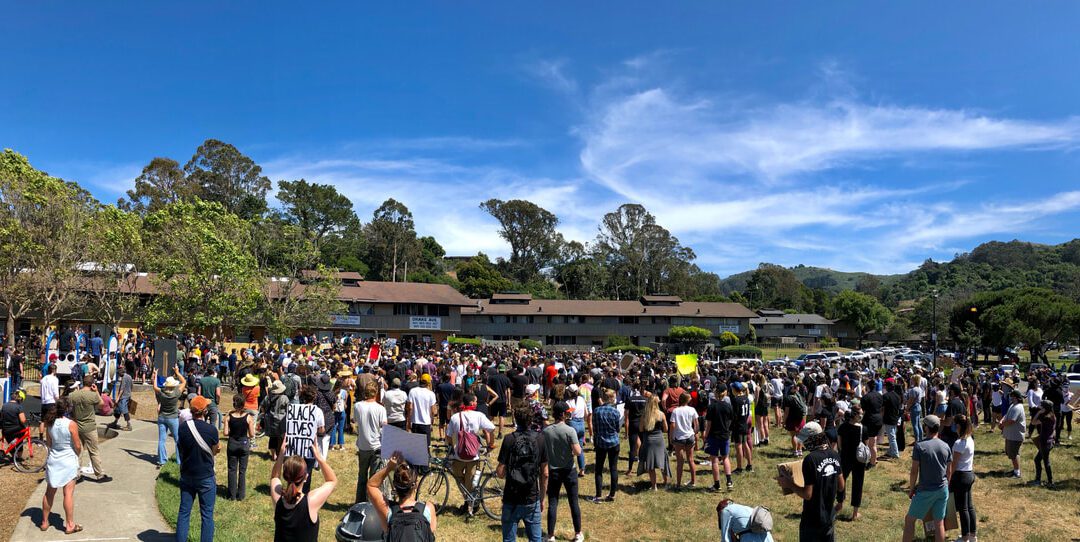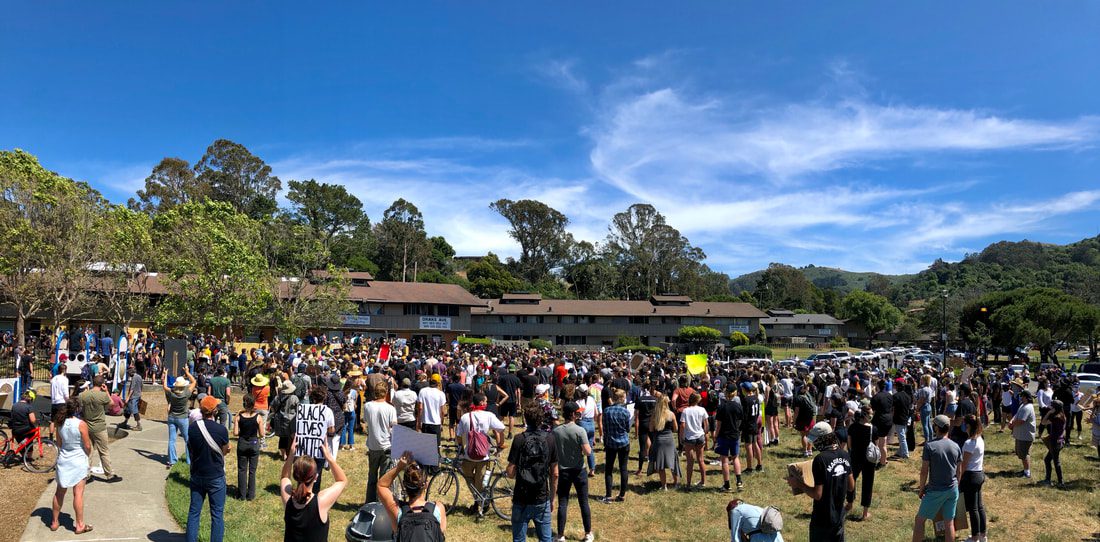 Click the image to download this sign, or others.
Click the image to download this sign, or others.
Instead of the extraordinary conflict we’ve witnessed in recent days, Marin City organizers created what felt like a much-needed reunion among neighbors whose relations can – and must – strengthen during dire moments like those we’re living through right now. The evidence that this was going to be a coalescing event arrived quickly, as swarms of people, including many families with children, walked and rode bikes from Mill Valley, down the MV-Sausalito Multi-Use Path and into Marin City to participate.
The event kicked off with nearly 1,000 people, according to the Marin County Sheriff’s Office, marching from the Gateway Shopping Center to Donahue Street to Drake Avenue before gathering near the new Marin City Skate Park and offices of longtime local organizations like Performing Stars of Marin and Bridge the Gap College Prep.
When organizers shouted out names of Marin’s towns and cities to see which were represented at the event, the loudest response came from Mill Valley attendees.
The event was organized by Paul Austin, whose Play Marin organization helped provide hundred of meals to feed families during the coronavirus crisis and as well as much-needed revenue to local restaurants in the process, along with Ayana Morgan-Woodard and several others.
“I was so impressed,” says Felecia Gaston, a longtime Marin City leader and director of Performing Stars. “Our young people did an incredible job making the event something special.”
Gaston says the event actually reminded her of the Marin City Blues, Jazz and Soul Party in the Park, which was held for 15 years over Labor Day weekend before succumbing to a drop in funding. The event regularly drew as many as 6,000 music fans from all over Marin to see blues stars like Joe Louis Walker and Sugar Pie DeSanto.”It was such a mixture of people from all over, and this was similar in that way,” Gaston says. “It was just what Marin City needed.”
“When I started seeing all those cars coming into the shopping center and all the people arriving on foot and by bike, I felt, ‘this is unreal,'” Gaston says. “The young people especially. And those people from all over got to hear directly from our young people about what they are experiencing.”
One of those people was Mill Valley resident Tara Ordonez, who walked down the path with her family to participate. “We were moved by the large, peaceful, supportive crowd,” she says. “It brought so many impassioned people together from so many walks of life. The speeches came from people across multiple generations and reflected their experiences in this community and ways to move forward with action. We hope this continues to unite us all to move forward and break down systemic racism in Marin and beyond.”
Educate Yourself
What our neighbors in Marin City are experiencing today is built on a long, troubled past of systemic discrimination, institutionalized obstacles and, frankly, a lack of sustained effort on issues like housing, food insecurity, educational access and health disparities by county and regional leaders. Marin City was created in 1942 as housing for employees who built ships during World War II at the nearby Marinship Corporation. When the war ended, African-Americans had fewer options to relocate due to widespread racial discrimination and exclusionary real estate covenants
Marin City leaders insist that Marin Housing Authority’s 60-year-old public housing project, has moved too slowly in addressing the dire need of building repairs, far beyond the annual funding it gets from the federal Housing and Urban Development Department and far beyond the public funds the county is interested in investing.
“People want to be able continue to afford to live in Marin City,” Gaston says. “Marin County owes it to Marin City to let the residents decide what they want to do.”
The major takeaway from all of this? Mill Valley showed up in great numbers to participate in a fantastic protest organized by some amazing leaders in Marin City. This is who we are as a community. But this can’t – CANNOT – be a one-time thing. The difficult, complicated history of our neighbors warrants our resolve and effort to move the needle and improve conditions.
Here are some resources for the road ahead:
Raising Race Conscious Children
Here’s a great compendium of fantastic nonprofits and local organizations doing great work in Marin City. (The list was created by Mill Valley residents)
Want to be an anti-racist? Here’s a place to start.
And here are 75 things that white people can do for racial justice.
How to Support Black-Owned Small Businesses
And to address the elephant in the room, Mill Valley Police Chief and Acting City Manager Alan Piombo put it well today: “Let me be clear – discrimination and systemic racism are of immediate local importance, here in Mill Valley.”


